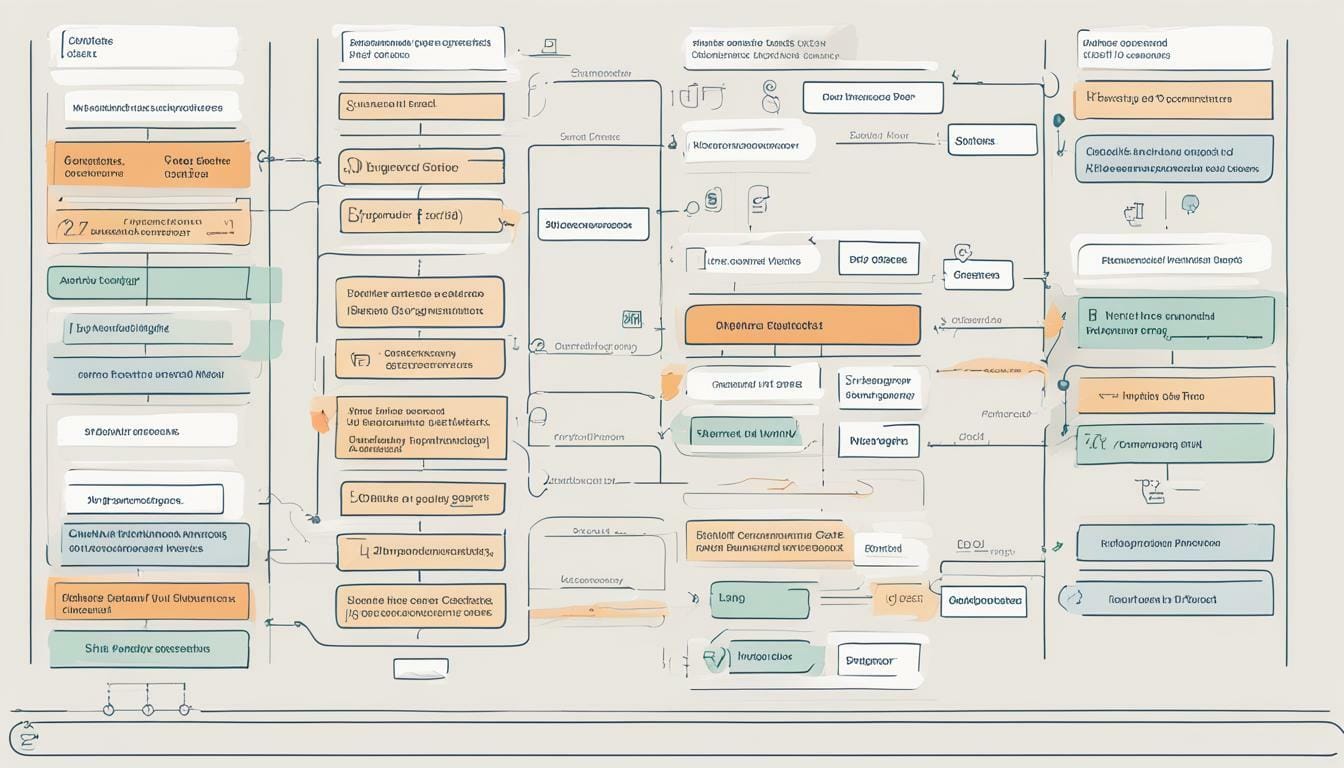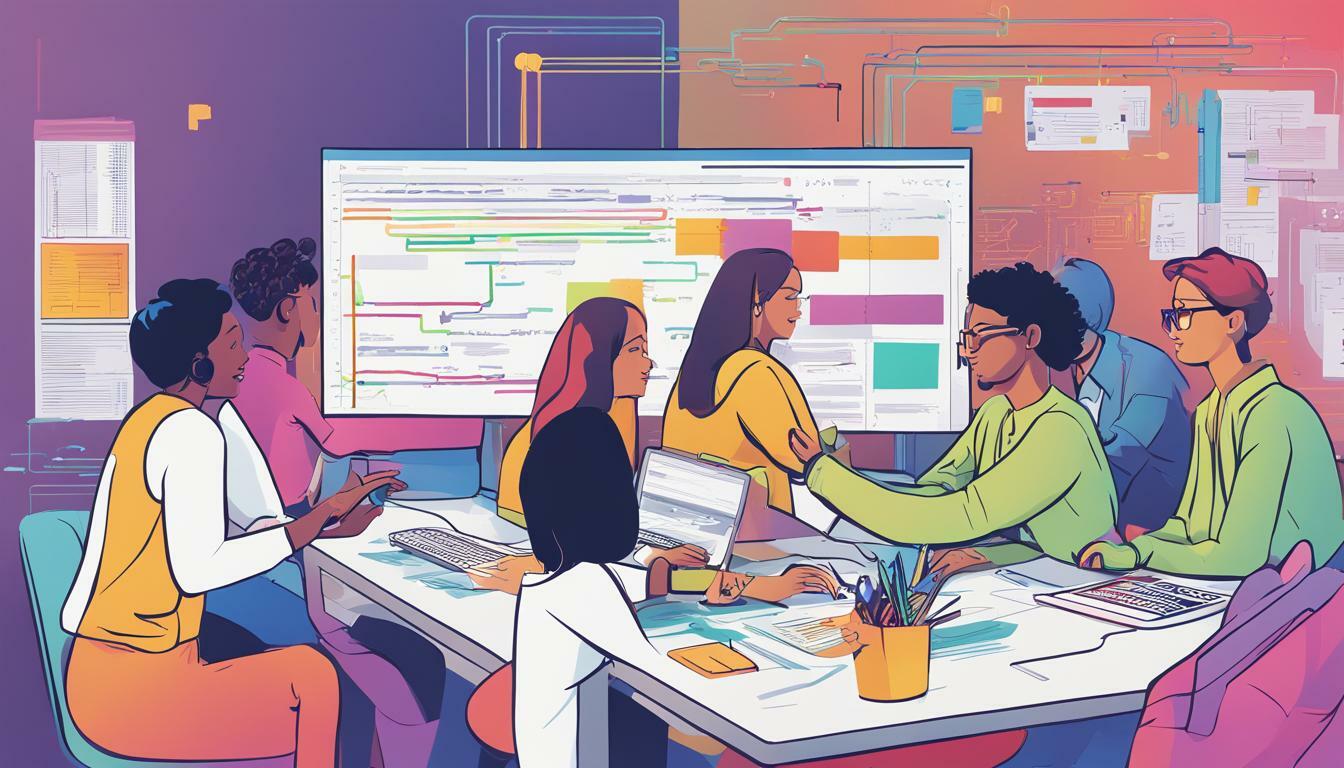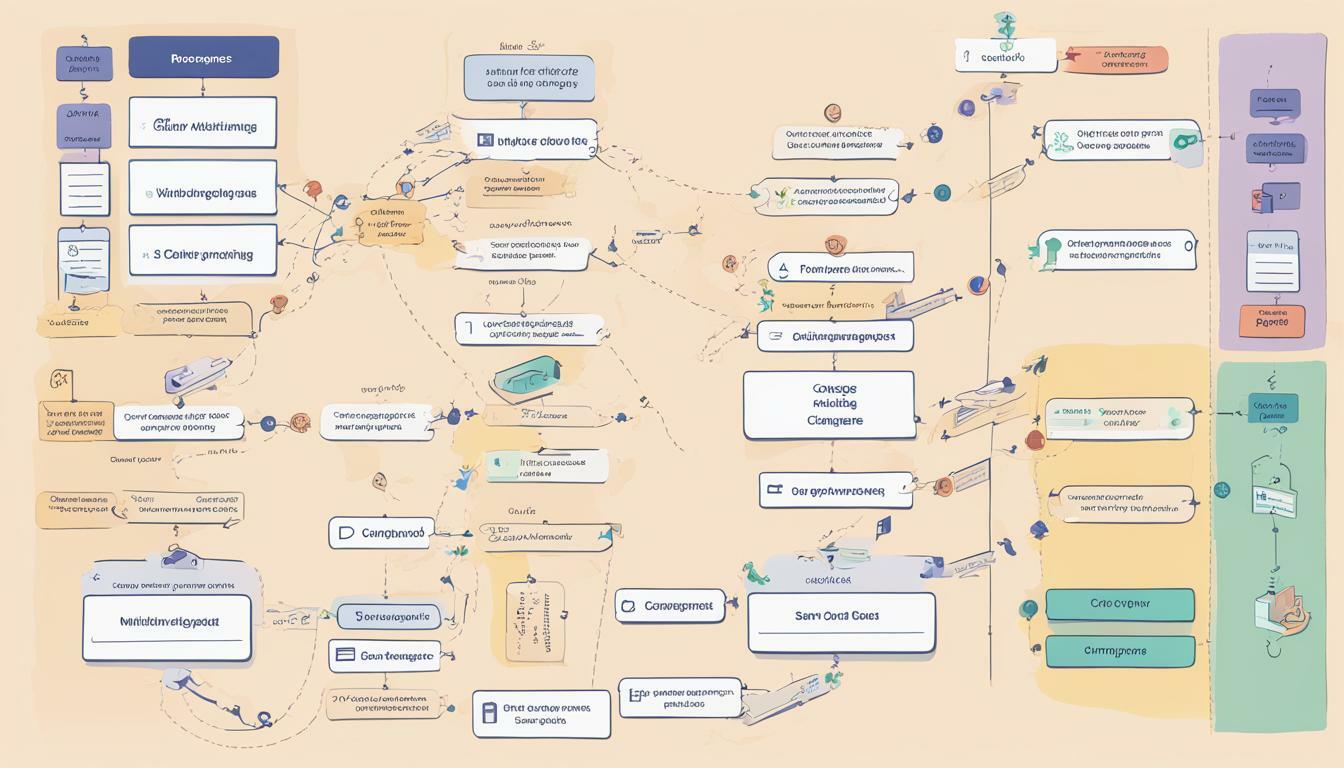Master Pull Request Best Practices for Better Coding Collaboration

Achieving high-quality code and successfully finishing a project largely depend on effective team cooperation. It’s essential to improve your proficiency in pull request strategies to become an excellent programmer. Adhering to pull request guidelines can enhance your work routine, foster teamwork and develop your coding competencies.
In this article, we will explore the fundamental concepts of pull requests and their role in collaborative coding projects. We will outline the essential elements of successful pull requests and provide practical tips for optimizing your workflow. Additionally, we’ll address common challenges associated with pull request collaboration and discuss strategies to overcome them. Finally, we’ll explore metrics that can help you evaluate the efficiency of your pull request process.
Key Takeaways:
- Follow pull request guidelines for effective collaboration and improved coding prowess.
- Optimize your pull request workflow to streamline the process and improve code quality.
- Embrace effective code reviews to address issues and promote a positive culture.
- Use metrics to evaluate the efficiency of your pull request process and identify areas for improvement.
Understanding Pull Requests: A Key Component of Collaboration
Pull requests are a fundamental aspect of collaboration in coding projects. They enable developers to share their code changes with the rest of the team and request feedback and approval before merging them into the main codebase. In simple terms, a pull request is a request to merge a branch into another branch.
The pull request workflow involves several steps, which may vary depending on the project’s specific requirements and the development team’s preferences. Typically, the process begins with a developer creating a new branch from the main codebase, making the desired changes, and submitting the pull request to the team.
Once the pull request is submitted, other team members can review the code changes, provide feedback, and suggest improvements. The pull request process may involve discussions, code reviews, and testing to ensure that the changes are relevant, bug-free, and aligned with the project’s objectives.

In larger teams, it’s common to use tools such as GitHub, Bitbucket, or GitLab to manage pull requests. These platforms offer features such as code diffs, inline commenting, and integration with continuous integration tools, making it easier to collaborate effectively and manage the pull request process efficiently.
Essential Elements of Successful Pull Requests
Successful pull requests are critical to effective collaboration during coding projects. Pull request management involves several key components that are essential to ensure seamless teamwork and improved code quality. In this section, we will discuss the elements that contribute to successful pull requests and the best practices associated with them.
Clear Communication
Clear communication is one of the most important elements of successful pull requests. This involves making sure that your pull request is concise and easy to understand. Be sure to describe the problem you are solving, the code changes you have made, and how these changes address the issue. This will help reviewers understand your changes and provide more relevant feedback.

It is also crucial to communicate any changes or updates you make to your pull request. If you make additional changes after the initial pull request, be sure to update the description and notify your teammates. This will prevent confusion and ensure that everyone is up-to-date on the status of the pull request.
Thorough Testing
Thorough testing is another critical element of successful pull requests. Before submitting your pull request, make sure that you have tested your changes thoroughly. This includes running any relevant unit tests, ensuring that the code is compatible with existing systems, and identifying and fixing any bugs or issues that may arise.
It is also important to document the testing process to provide context for your changes. This will help reviewers understand the decisions you have made and ensure that your changes are consistent with the project’s goals and requirements.
Proper Documentation
Proper documentation is the final essential element of successful pull requests. This involves creating clear and concise documentation for your changes, including comments and code annotations. Documentation provides important context for your code changes and helps reviewers understand the reasoning behind your decisions.
Documentation should be detailed enough to inform your teammates of changes made, but not so extensive that it becomes difficult to read. By providing clear documentation, you are showing your teammates that you respect their time and are committed to making the project run smoothly.
By following these essential elements of successful pull requests, you can ensure that your code changes are well-received, and that your team can collaborate more effectively.
Optimizing Your Pull Request Workflow
As a developer, I have found that optimizing your pull request workflow can significantly improve collaboration and enhance code quality. Here are some practical pull request tips to streamline the process:
- Keep pull requests small: Breaking up your changes into smaller, more manageable chunks makes it easier to review and merge your code. It also reduces the risk of conflicts and makes it easier to track changes over time.
- Set clear objectives: Clearly defining the purpose and scope of each pull request helps reviewers understand the context of your changes and identify potential issues more effectively.
- Use templates: Creating pull request templates with predefined sections and guidelines can help standardize the review process and make it easier to provide feedback.
- Automate code formatting: Integrating automated tools for code formatting and linting can help ensure consistency and reduce the time spent on manual code review.
By implementing these pull request best practices, you can optimize your workflow and improve the efficiency of your team’s collaboration.

Streamlining the Pull Request Process
To further optimize your pull request workflow, consider streamlining the process by automating repetitive tasks:
| Task | Automation Tool |
|---|---|
| Build and test code changes | Continuous Integration (CI) tools like Travis CI, Jenkins, and CircleCI |
| Code review reminders and notifications | GitHub and Bitbucket’s built-in notifications or third-party apps like Pull Reminders |
| Automated merges and deployments | Continuous Deployment (CD) tools like AWS CodeDeploy or Google Cloud Build |
By leveraging these tools and integrations, you can simplify your pull request process, reduce human error, and improve your team’s productivity.
Collaborating Effectively with Pull Request Reviews
One of the most crucial aspects of successful pull requests is effective code reviews. By providing constructive feedback, addressing issues, and fostering a positive code review culture, you can enhance collaboration and improve the overall quality of your code.
Here are some best practices for effective pull request reviews:
- Be specific: When providing feedback, be as specific as possible. Instead of saying “This code doesn’t look right,” explain what specifically needs to be addressed and how it can be improved.
- Be respectful: Remember that code reviews are not personal attacks. Use a respectful and professional tone when providing feedback.
- Be timely: Don’t delay your code reviews. Timely feedback can help prevent small issues from turning into big problems.
- Be open-minded: Keep an open mind when receiving feedback, and consider all suggestions for improvement.
By following these best practices, you can promote a positive code review culture and foster a collaborative environment where everyone’s input is valued. Effective pull request reviews can help improve the quality of your code and contribute to the success of your coding projects.

“Code reviews are an essential aspect of successful pull requests. They provide an opportunity for team members to collaborate, share feedback, and improve the overall quality of the codebase. With effective code reviews, you can enhance your coding prowess and contribute to the success of your projects.”
Integrating Automated Testing in Pull Requests
Incorporating automated testing into your pull request process is one of the best practices for effective collaboration. Automated testing ensures that code changes are thoroughly tested before they are merged into the main branch, reducing the likelihood of introducing bugs and errors. By optimizing your pull request workflow with automated testing, you can significantly improve the quality and stability of your code.
There are various continuous integration (CI) tools that you can use to integrate automated testing into your pull requests. These tools run your tests automatically and provide feedback in real-time, making it easier to detect and fix issues early on in the process. Setting up a CI pipeline can be challenging, but the benefits are well worth the effort.
Here are some tips for integrating automated testing into your pull request process:
- Choose a reliable CI tool that integrates well with your code repository.
- Define clear directions for your tests in your pull request guidelines.
- Set up an automated test suite that covers all critical aspects of your code base.
- Make sure your automated tests are well-organized and easy to read.
- Review your test results and address any failures before merging the code changes.
Integrating automated testing into your pull request process can be challenging, but it is a best practice for effective collaboration. By optimizing your pull request workflow with automated testing, you can increase efficiency and improve code quality, while reducing the likelihood of introducing bugs and errors.

Enhancing Code Quality through Pull Request Analysis
As developers, we strive to write code that is reliable, maintainable, and easy to understand. Pull request analysis is a valuable technique that can help us achieve these goals. By using automated tools and manual inspections, we can identify and fix potential issues before they are merged into the codebase.
Code Linting
One important aspect of pull request analysis is code linting. This involves using a tool to check the code for stylistic and syntax errors, as well as potential bugs and performance issues. By catching these issues early on, we can ensure that the code is consistent, readable, and efficient.
| Benefits of Code Linting | Examples of Tools |
|---|---|
| Enforce coding standards | ESLint, Pylint |
| Identify potential bugs | JSLint, Flake8 |
| Optimize performance | CSSLint, JSHint |
Static Analysis
Another useful technique for pull request analysis is static analysis. This involves using a tool to analyze the code without actually running it, to identify potential issues such as security vulnerabilities, race conditions, and other bugs. By catching these issues early on, we can ensure that the code is reliable and secure.
Manual Inspections
In addition to automated tools, manual inspections can also be a valuable part of pull request analysis. By having other developers review the code, we can identify potential issues that may have been missed by automated tools. This can also help to improve the overall quality of the codebase by encouraging collaboration and knowledge sharing.

By incorporating pull request analysis into our workflow, we can enhance the quality and reliability of our code. This can lead to fewer bugs, faster deployments, and a more efficient development process. By embracing pull request best practices and effective collaboration, we can achieve success in our coding projects.
Overcoming Challenges in Pull Request Collaboration
Effective pull request collaboration requires teamwork, communication, and a collaborative environment. However, it’s not always smooth sailing, and there are often challenges that can arise during the process. Here are some common challenges and strategies to overcome them:
Managing Conflicts
Conflicts can occur when two or more team members attempt to implement changes to the same codebase. This can result in merge conflicts that need to be resolved before the pull request can be approved. To overcome this challenge, it’s important to establish clear guidelines for code ownership and collaboration within the team. This can include assigning specific tasks or sections of the code to team members, or using version control systems to manage changes effectively.
Handling Feedback
Receiving feedback on your code can be challenging, especially if it’s critical. It’s important to remember that feedback is not a personal attack, but rather an opportunity to improve your code and learn from your mistakes. When providing feedback, it’s essential to be constructive and provide specific suggestions for improvement. When receiving feedback, it’s crucial to remain open-minded and receptive to suggestions.
Promoting Teamwork
Successful pull request collaboration requires teamwork and collaboration. It’s essential to create a positive and inclusive team environment that encourages collaboration and innovation. This can include regular team meetings, open communication channels, and team-building activities. Celebrating successes and recognizing team members’ contributions can also foster a positive team culture.

By overcoming these common challenges, you can promote effective pull request collaboration and enhance your workflow. Remember, collaboration is a team effort, and it’s important to work together to achieve success.
What Version of Word Do I Need to Use for Master Pull Request Best Practices?
To effectively implement master pull request best practices, it is crucial to know how to identify the Word version you need to use. Recognizing the correct Word version ensures compatibility for smooth collaboration and effective document sharing among team members. By being aware of how to identify word version, you can ensure that everyone involved is on the same page, promoting seamless workflow and efficient version control.
Measuring Success: Metrics for Pull Request Efficiency
As with any project management process, it’s essential to measure the effectiveness of your pull request workflow. By tracking key metrics, you can identify areas for improvement and optimize your pull request management. Here are some essential metrics to consider:
| Metric | Description |
|---|---|
| Pull Request Lead Time | The time it takes for a pull request to be opened until it is merged into the main branch. A shorter lead time indicates a more efficient workflow. |
| Pull Request Review Time | The time it takes for a pull request to be reviewed and approved. A shorter review time indicates a more streamlined collaboration process. |
| Code Review Feedback | The number and severity of issues found during code review. A lower number of issues indicates higher code quality and better collaboration. |
| Code Review Participation | The percentage of team members who participate in code reviews. Higher participation indicates a more collaborative culture and better knowledge sharing. |
By measuring these and other relevant metrics, you can gain valuable insights into the efficiency and effectiveness of your pull request workflow. Use this information to identify areas for improvement and optimize your pull request management for better teamwork and increased code quality.

Conclusion
As a professional copywriting journalist, I can attest to the importance of mastering pull request best practices for better coding collaboration. By following pull request guidelines, understanding the pull request workflow, and optimizing your pull request management, you can enhance your coding prowess and contribute to successful projects.
Effective pull request reviews, integrating automated testing, and leveraging pull request analysis can all contribute to improving your coding quality and reliability. It’s important to address common challenges in pull request collaboration, such as managing conflicts and handling feedback, to achieve effective teamwork and positive code review culture.
Measuring pull request efficiency through key metrics and indicators can help you evaluate the effectiveness of your pull request process and identify areas for improvement. By consistently implementing pull request best practices and optimizing your workflow, you can achieve greater efficiency and success in your coding projects.
Remember, pull request best practices and workflow are crucial components of collaboration and effective teamwork. By embracing these practices, you can enhance your coding abilities and contribute to the success of your projects.
Master pull request best practices and optimize your workflow today!
FAQ
Q: What are pull request best practices?
A: Pull request best practices are guidelines and techniques that enhance collaboration during coding projects. They help ensure code quality, minimize conflicts, and streamline the review and merge process.
Q: Why is following pull request guidelines important?
A: Following pull request guidelines is important because it promotes effective teamwork and improved coding prowess. It helps maintain a consistent and reliable codebase, encourages constructive feedback, and fosters a positive code review culture.
Q: What is a pull request workflow?
A: A pull request workflow is a sequence of steps that occur when a developer proposes changes to a codebase. It typically involves creating a branch, making changes, opening a pull request, and undergoing review and approval before merging the changes into the main codebase.
Q: How can clear communication contribute to successful pull requests?
A: Clear communication is essential for successful pull requests. It ensures that the purpose, scope, and intent of the changes are understood by all team members. It helps address any questions or concerns, fosters effective collaboration, and minimizes misunderstandings.
Q: Why is thorough testing important in pull request management?
A: Thorough testing is important in pull request management because it helps identify and resolve issues before they are merged into the main codebase. It ensures that the changes are functioning as expected, maintains code quality, and minimizes the risk of introducing bugs or breaking existing functionality.
Q: What role does proper documentation play in effective pull request management?
A: Proper documentation is crucial in effective pull request management. It provides clarity and context for the changes, allows for easier understanding and review by other team members, and serves as a reference for future maintenance or troubleshooting.
Q: How can I optimize my pull request workflow?
A: You can optimize your pull request workflow by adopting strategies such as keeping pull requests small and focused, utilizing automation and continuous integration tools, establishing clear review and approval processes, and regularly reflecting on and improving your workflow based on feedback and metrics.
Q: What are some tips for providing effective feedback during pull request reviews?
A: Some tips for providing effective feedback during pull request reviews include being specific and actionable, focusing on the code rather than the person, providing constructive suggestions, and maintaining a positive and respectful tone. It’s also helpful to provide examples or explanations to support your feedback.
Q: How can I integrate automated testing in pull requests?
A: You can integrate automated testing in pull requests by utilizing continuous integration tools that automatically run tests on your changes. This helps ensure the stability and quality of your code, identify any regressions, and provide timely feedback during the review process.
Q: What is the role of pull request analysis in enhancing code quality?
A: Pull request analysis plays a crucial role in enhancing code quality. It involves code linting, static analysis, and other code inspection techniques that help identify potential issues, enforce coding standards, and improve the overall reliability and maintainability of your codebase.
Q: How can I overcome common challenges in pull request collaboration?
A: To overcome common challenges in pull request collaboration, it’s important to establish clear communication channels, set expectations for review and response times, address conflicts or disagreements in a constructive manner, and foster a culture of teamwork and mutual respect. Regular retrospectives and continuous improvement can also help identify and address any recurring challenges.
Q: What are some metrics for measuring pull request efficiency?
A: Some metrics for measuring pull request efficiency include the average time to merge, the number of iterations or rounds of review, the percentage of merged pull requests, and the feedback turnaround time. These metrics can help evaluate the effectiveness of your pull request process, identify bottlenecks, and guide improvements.






